选择性必修第三册Unit 5 Poems Learning about Language(课件)
文档属性
| 名称 | 选择性必修第三册Unit 5 Poems Learning about Language(课件) |
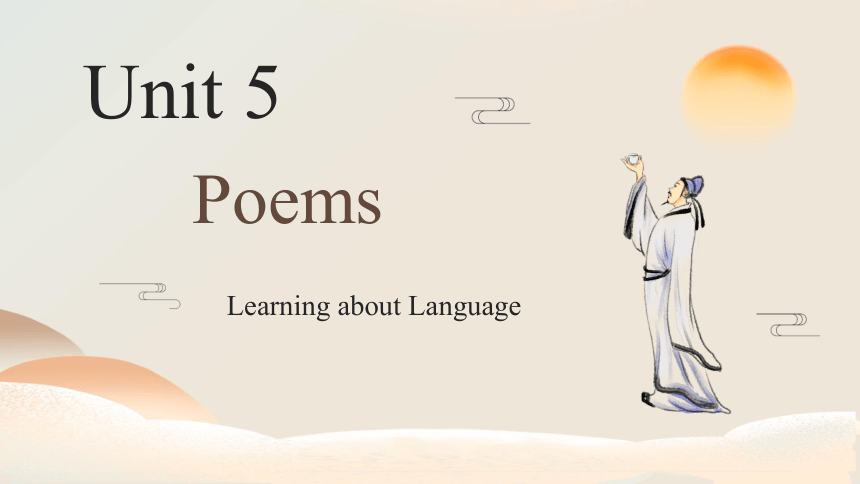
|
|
| 格式 | zip | ||
| 文件大小 | 1.1MB | ||
| 资源类型 | 试卷 | ||
| 版本资源 | 人教版(2019) | ||
| 科目 | 英语 | ||
| 更新时间 | 2023-03-06 17:02:33 | ||
图片预览

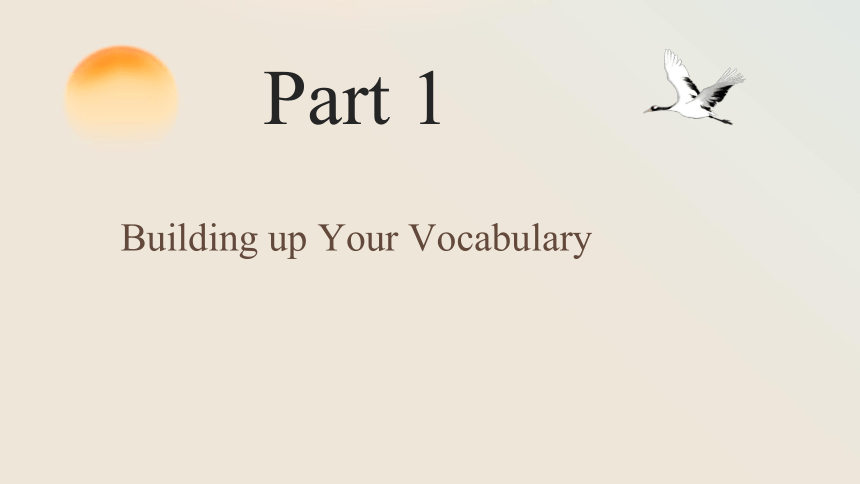
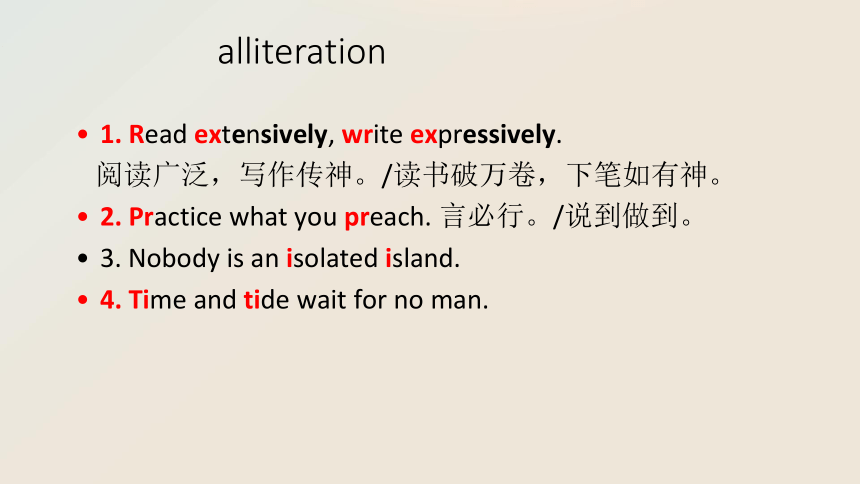
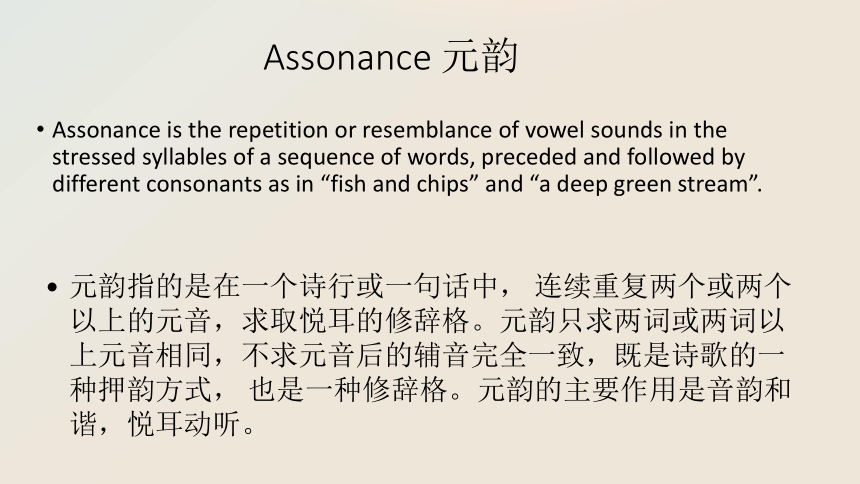
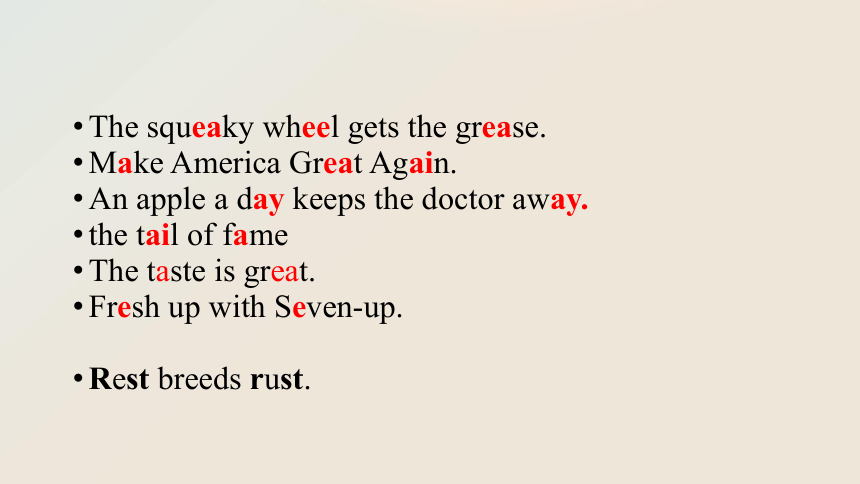
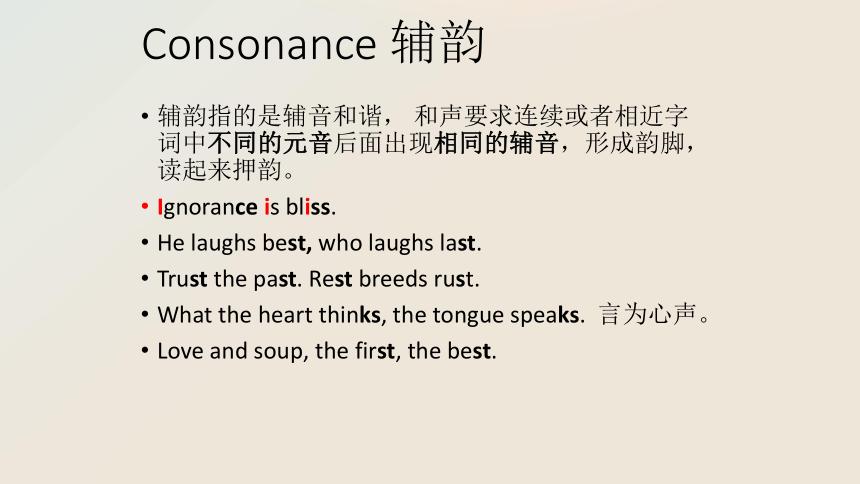
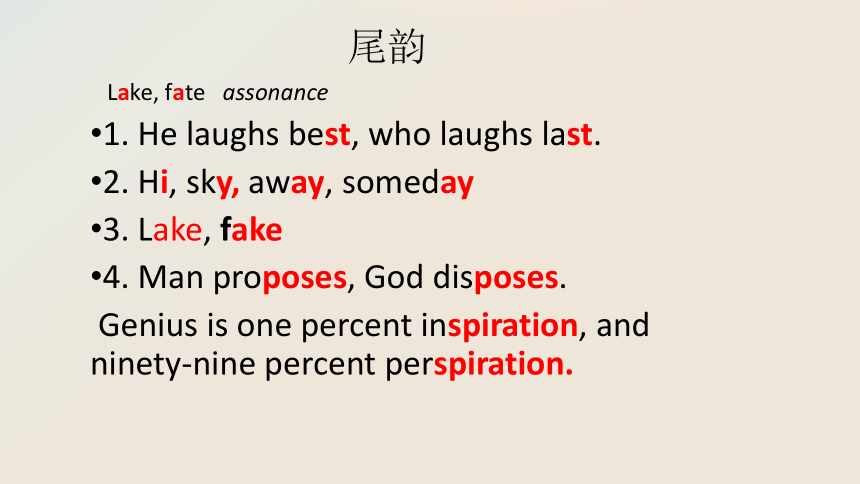
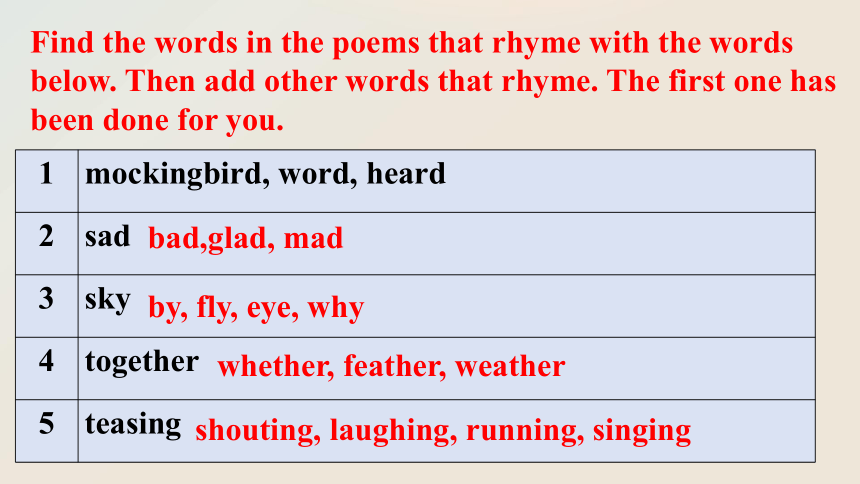
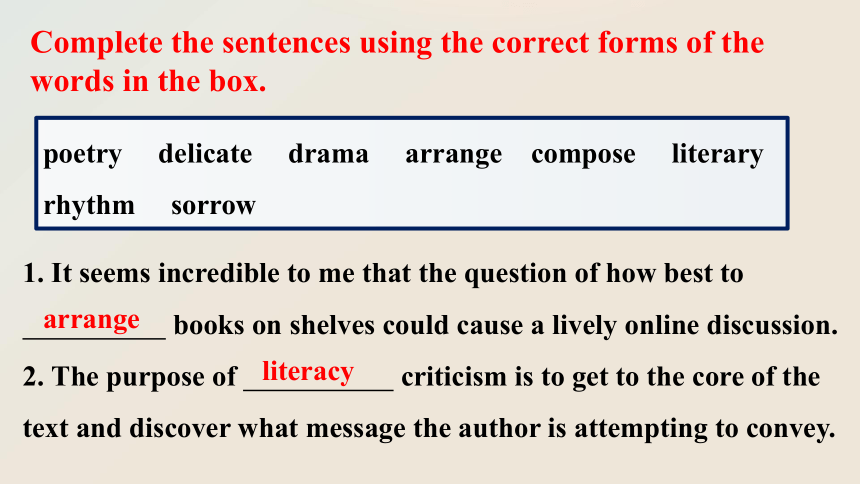
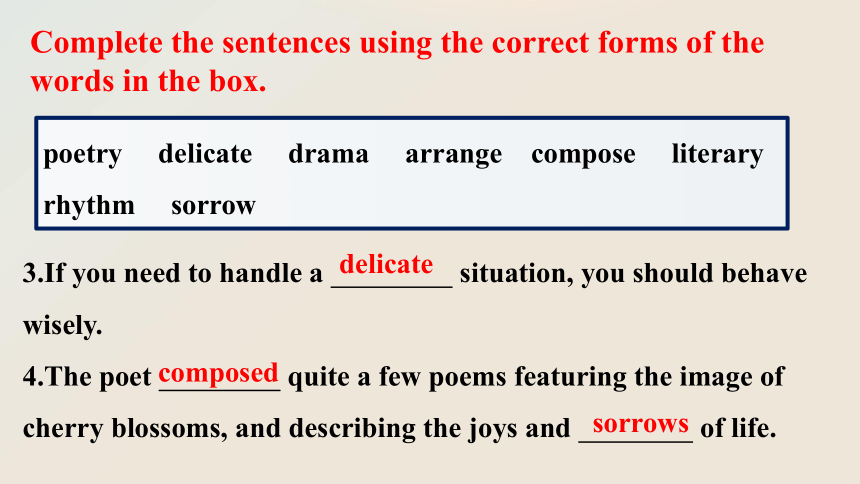
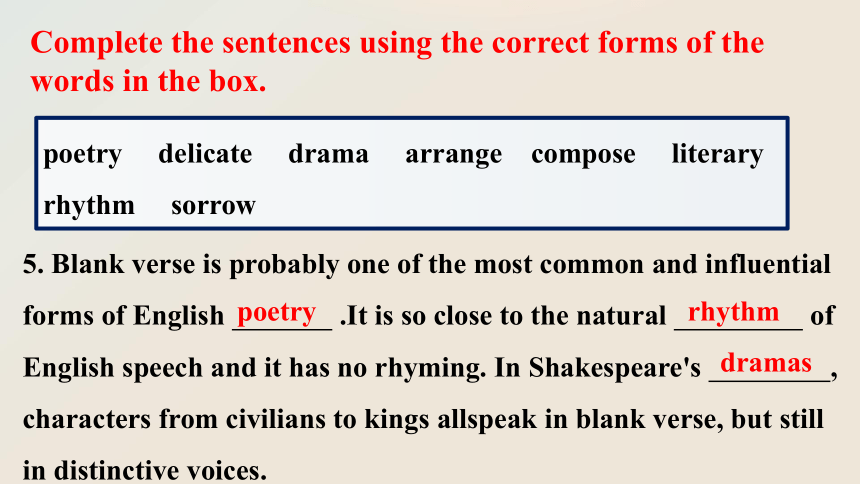
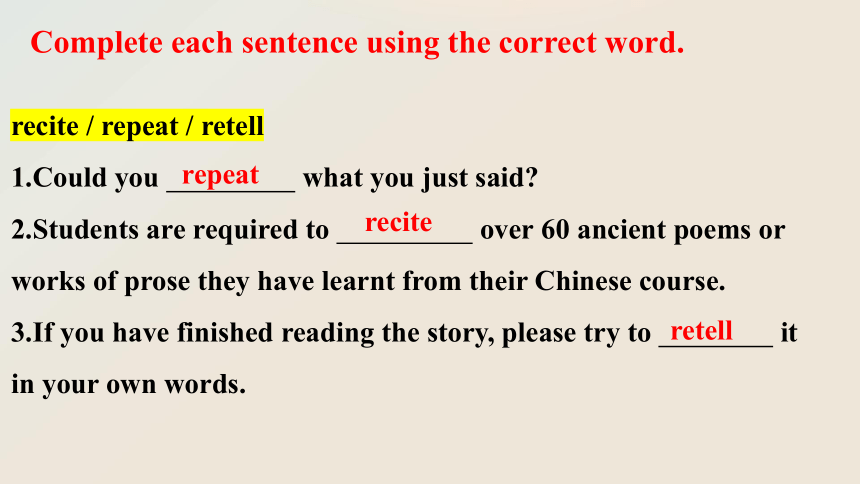
文档简介
(共35张PPT)
Learning about Language
Unit 5
Poems
Part 1
Building up Your Vocabulary
alliteration
1. Read extensively, write expressively.
阅读广泛,写作传神。/读书破万卷,下笔如有神。
2. Practice what you preach. 言必行。/说到做到。
3. Nobody is an isolated island.
4. Time and tide wait for no man.
Assonance 元韵
Assonance is the repetition or resemblance of vowel sounds in the stressed syllables of a sequence of words, preceded and followed by different consonants as in “fish and chips” and “a deep green stream”.
元韵指的是在一个诗行或一句话中, 连续重复两个或两个以上的元音,求取悦耳的修辞格。元韵只求两词或两词以上元音相同,不求元音后的辅音完全一致,既是诗歌的一种押韵方式, 也是一种修辞格。元韵的主要作用是音韵和谐,悦耳动听。
The squeaky wheel gets the grease.
Make America Great Again.
An apple a day keeps the doctor away.
the tail of fame
The taste is great.
Fresh up with Seven-up.
Rest breeds rust.
Consonance 辅韵
辅韵指的是辅音和谐, 和声要求连续或者相近字词中不同的元音后面出现相同的辅音,形成韵脚,读起来押韵。
Ignorance is bliss.
He laughs best, who laughs last.
Trust the past. Rest breeds rust.
What the heart thinks, the tongue speaks. 言为心声。
Love and soup, the first, the best.
尾韵
Lake, fate assonance
1. He laughs best, who laughs last.
2. Hi, sky, away, someday
3. Lake, fake
4. Man proposes, God disposes.
Genius is one percent inspiration, and ninety-nine percent perspiration.
1 mockingbird, word, heard
2 sad
3 sky
4 together
5 teasing
Find the words in the poems that rhyme with the words below. Then add other words that rhyme. The first one has been done for you.
bad,glad, mad
by, fly, eye, why
whether, feather, weather
shouting, laughing, running, singing
Complete the sentences using the correct forms of the words in the box.
poetry delicate drama arrange compose literary rhythm sorrow
1. It seems incredible to me that the question of how best to
books on shelves could cause a lively online discussion.
2. The purpose of criticism is to get to the core of the text and discover what message the author is attempting to convey.
arrange
literacy
Complete the sentences using the correct forms of the words in the box.
poetry delicate drama arrange compose literary rhythm sorrow
3.If you need to handle a situation, you should behave wisely.
4.The poet quite a few poems featuring the image of cherry blossoms, and describing the joys and of life.
delicate
composed
sorrows
Complete the sentences using the correct forms of the words in the box.
poetry delicate drama arrange compose literary rhythm sorrow
5. Blank verse is probably one of the most common and influential forms of English .It is so close to the natural of English speech and it has no rhyming. In Shakespeare's , characters from civilians to kings allspeak in blank verse, but still in distinctive voices.
poetry
rhythm
dramas
Complete each sentence using the correct word.
recite / repeat / retell
1.Could you what you just said
2.Students are required to over 60 ancient poems or works of prose they have learnt from their Chinese course.
3.If you have finished reading the story, please try to it in your own words.
repeat
recite
retell
Complete each sentence using the correct word.
emotion / mood / spirit
4.Her rose at the approach of the summer holidays.
5.We couldn't see any in him. He is so calm in spite of what he has experienced.
6.Rainy days always put everyone in a depressed .
spirits
emotions
mood
Part 2
Review Useful Structures
前置定语:单个词作定语
a train(n.) station a tough(adj.) girl
the changing(现在分词) weather
the developed(过去分词) country
后置定语:多个词/短语/ 句子→定语从句
the life in the future(介词短语)
the lecture beneficial to your future(形容词短语)
a play put on by the students(过去分词短语)
the student eating snacks in class(现在分词短语)
a way to solve the problem(不定式)
定语从句:
1.n.+定从(关系词+定从)
先行词:被定从修饰的成分
关系词:2
关系代词+关系副词
关系代词:6
that/which/who/whom/whose/as 做成分
关系副词:3
when/where/why 做成分(只能做状语)
that(sb/sth): 主语、宾语、表语
which(sth): 主语、宾语、表语
who(sb):主语、宾语、表语
whom(sb): 宾语、表语
whose(sb/sth):定语“......的”
a book whose cover=a book’s cover 书的封面
a girl whose father=a girl’s father女孩的父亲
as(sth):主语、宾语、表语“正如,正像”
n.(时间)+when(定从)(when状语:时间状语)
n.(地点)+where(定从)(where状语:地点状语)
n.(原因)+why(定从)(why状语:原因状语)
2. 定从的拆分公式:
(1)关系词 谓语1 谓语2
关系词前方没有谓语,后方出现谓语,从句从关系词开始,到第二个谓语之前结束
The girl that I know comes from Shantou.
(2)谓语1 关系词 谓语2
关系词在中间,谓语动词在两边,从句从关系词开始到句子结束
I know the girl that comes from Shantou.
3.定从的分类:2
限制性定语从句+非限制性定语从句
(1)不带逗号的叫限制性定从,带逗号的叫非限制定从
(除了that以外,其他所有的关系词都可以引导非限制性定从)
(2)限制性定从:起到了修饰限定的作用,去掉该从句,会影响主句的意思
非限制性定从:起到了补充说明的作用,去掉该从句,不会影响主句的意思
He has two sisters, who are working in the city.
他有两个妹妹,他们在城市里面上班。
请问他有几个妹妹?
2个
He has two sisters who are working in the city.
他有两个在城市里工作的妹妹。
请问他有几个妹妹?
不一定两个妹妹,可能有多个
All the Greeks, who are philosophers(哲学家), are very intelligent.
Greeks=philosophers?
正确
Greeks=intelligent?
正确
所有的希腊人是聪明的,所有的希腊人都是哲学家。
All the Greeks who are philosophers(哲学家) are very intelligent.
Greeks=philosophers?
错误
philosophers=intelligent?
错误
philosophers and Greeks=intelligent?
正确
所有是哲学家的希腊人都很聪明。
哲学家(是希腊人、不是希腊人) 希腊人(是哲学家、不是哲学家)
既是哲学家又是希腊人=聪明
非限制性定从:
1.修饰限定前方n.
翻译:重复这个名词
2.修饰前方句子
翻译:这/这件事
Connect the sentences using relative pronouns, or adverbs. Then put the sentences in the correct order to compose a passage.
The Crescent Moon is perhaps the most famous collection of children’s poems. It is known to people in China.
The Crescent Moon, which is known to people in China, is perhaps the most famous collection of children’s poems.
指物,作主语
Connect the sentences using relative pronouns, or adverbs. Then put the sentences in the correct order to compose a passage.
There are also many poems written from a child’s perspective. In these poems the poet Tagore shows a sympathetic understanding of children’s feelings.
There are also many poems written from a child’s perspective in which the poet Tagore shows a sympathetic understanding of children’s feelings.
指物,作地点状语 = where
Connect the sentences using relative pronouns, or adverbs. Then put the sentences in the correct order to compose a passage.
The English version of the book contains nearly 50 poems. The focus of the poems is on the parent-child relationship.
The English version of the book contains nearly 50 poems, the focus of which is on the parent-child relationship.
指物,作介词宾语
Connect the sentences using relative pronouns, or adverbs. Then put the sentences in the correct order to compose a passage.
The initial poems were written from the perspective of a mother. The mother loves her baby at play and at rest, in laughter and in tears.
The initial poems were written from the perspective of a mother who loves her baby at play and at rest, in laughter and in tears.
指人,作主语
Connect the sentences using relative pronouns, or adverbs. Then put the sentences in the correct order to compose a passage.
Many people love to read this collection of poems. The reason is that they can feel the warmth of love and enjoy the innocence of childhood.
The reason why many people love to read collection of poems is that they can feel the warmth of love and enjoy the innocence of childhood.
指原因,作原因状语
Connect the sentences using relative pronouns, or adverbs. Then put the sentences in the correct order to compose a passage.
It was written by the Indian poet Tagore. Tagore was the first Asian to win the Nobel Prize in Literature.
It was written by the Indian poet Tagore who was the first Asian to win the Nobel Prize in Literature.
指人,作主语
Find the relative clauses on page 50-51, and circle the relative words.
1. There are various reasons why people compose poetry.
2. One of the simplest kinds of poem is the “list poem”, which
contains a list of things, people, ideas, or descriptions that
develop a particular theme.
3. List poems have a flexible line length and repeated phrases
which give both a pattern and a rhythm to the poem.
4. Another simple form of poem that amateurs can easily write
is the cinquain, which is made up of five lines.
5. The haiku poem on the right is a translation from Japanese,
which shows a moment in the life of a delicate butterfly.
Read the following introduction about the Brownings. Help the author edit the passage, using relative clauses if necessary.
1. ... you will find the names of Robert and Elizabeth
Barrett Browning. They were one of the most romantic
literary couples of the Victorian era.
Revised:
... you will find the names of Robert and
Elizabeth Barrett Browning, who were one of the most romantic literary couples of the Victorian era.
2. In 1844, Elizabeth’s Poems brought her great success.
It also attracted the admiration of poet Robert Browning.
Revised:
In 1844, Elizabeth’s Poems brought her great
success and it also attracted the admiration of poet Robert Browning.
3. The couple exchanged many letters. These letters obviously
helped sow the seeds of love between the two.
Revised:
The couple exchanged many letters, which
obviously helped sow the seeds of love between the two.
4. However, their subsequent marriage was carried out in
secret. It was because Barrett’s father was a dominant
and selfish man. He would refuse to let his daughter go.
Revised:
However, their subsequent marriage was
carried out in secret because her father was a dominant
and selfish man who would refuse to let his daughter go.
5. The couple moved to Italy in 1846. Elizabeth lived there
for the rest of her life.
Revised:
The couple moved to Italy in 1846, where
Elizabeth lived for the rest of her life.
6. The best evidence was Sonnets from the Portuguese. They
were written during the time when she was in love with
Robert Browning.
Revised:
The best evidence that can be found is Sonnets
from the Portuguese that were written during the time when she was in love with Robert Browning.
Thanks
Learning about Language
Unit 5
Poems
Part 1
Building up Your Vocabulary
alliteration
1. Read extensively, write expressively.
阅读广泛,写作传神。/读书破万卷,下笔如有神。
2. Practice what you preach. 言必行。/说到做到。
3. Nobody is an isolated island.
4. Time and tide wait for no man.
Assonance 元韵
Assonance is the repetition or resemblance of vowel sounds in the stressed syllables of a sequence of words, preceded and followed by different consonants as in “fish and chips” and “a deep green stream”.
元韵指的是在一个诗行或一句话中, 连续重复两个或两个以上的元音,求取悦耳的修辞格。元韵只求两词或两词以上元音相同,不求元音后的辅音完全一致,既是诗歌的一种押韵方式, 也是一种修辞格。元韵的主要作用是音韵和谐,悦耳动听。
The squeaky wheel gets the grease.
Make America Great Again.
An apple a day keeps the doctor away.
the tail of fame
The taste is great.
Fresh up with Seven-up.
Rest breeds rust.
Consonance 辅韵
辅韵指的是辅音和谐, 和声要求连续或者相近字词中不同的元音后面出现相同的辅音,形成韵脚,读起来押韵。
Ignorance is bliss.
He laughs best, who laughs last.
Trust the past. Rest breeds rust.
What the heart thinks, the tongue speaks. 言为心声。
Love and soup, the first, the best.
尾韵
Lake, fate assonance
1. He laughs best, who laughs last.
2. Hi, sky, away, someday
3. Lake, fake
4. Man proposes, God disposes.
Genius is one percent inspiration, and ninety-nine percent perspiration.
1 mockingbird, word, heard
2 sad
3 sky
4 together
5 teasing
Find the words in the poems that rhyme with the words below. Then add other words that rhyme. The first one has been done for you.
bad,glad, mad
by, fly, eye, why
whether, feather, weather
shouting, laughing, running, singing
Complete the sentences using the correct forms of the words in the box.
poetry delicate drama arrange compose literary rhythm sorrow
1. It seems incredible to me that the question of how best to
books on shelves could cause a lively online discussion.
2. The purpose of criticism is to get to the core of the text and discover what message the author is attempting to convey.
arrange
literacy
Complete the sentences using the correct forms of the words in the box.
poetry delicate drama arrange compose literary rhythm sorrow
3.If you need to handle a situation, you should behave wisely.
4.The poet quite a few poems featuring the image of cherry blossoms, and describing the joys and of life.
delicate
composed
sorrows
Complete the sentences using the correct forms of the words in the box.
poetry delicate drama arrange compose literary rhythm sorrow
5. Blank verse is probably one of the most common and influential forms of English .It is so close to the natural of English speech and it has no rhyming. In Shakespeare's , characters from civilians to kings allspeak in blank verse, but still in distinctive voices.
poetry
rhythm
dramas
Complete each sentence using the correct word.
recite / repeat / retell
1.Could you what you just said
2.Students are required to over 60 ancient poems or works of prose they have learnt from their Chinese course.
3.If you have finished reading the story, please try to it in your own words.
repeat
recite
retell
Complete each sentence using the correct word.
emotion / mood / spirit
4.Her rose at the approach of the summer holidays.
5.We couldn't see any in him. He is so calm in spite of what he has experienced.
6.Rainy days always put everyone in a depressed .
spirits
emotions
mood
Part 2
Review Useful Structures
前置定语:单个词作定语
a train(n.) station a tough(adj.) girl
the changing(现在分词) weather
the developed(过去分词) country
后置定语:多个词/短语/ 句子→定语从句
the life in the future(介词短语)
the lecture beneficial to your future(形容词短语)
a play put on by the students(过去分词短语)
the student eating snacks in class(现在分词短语)
a way to solve the problem(不定式)
定语从句:
1.n.+定从(关系词+定从)
先行词:被定从修饰的成分
关系词:2
关系代词+关系副词
关系代词:6
that/which/who/whom/whose/as 做成分
关系副词:3
when/where/why 做成分(只能做状语)
that(sb/sth): 主语、宾语、表语
which(sth): 主语、宾语、表语
who(sb):主语、宾语、表语
whom(sb): 宾语、表语
whose(sb/sth):定语“......的”
a book whose cover=a book’s cover 书的封面
a girl whose father=a girl’s father女孩的父亲
as(sth):主语、宾语、表语“正如,正像”
n.(时间)+when(定从)(when状语:时间状语)
n.(地点)+where(定从)(where状语:地点状语)
n.(原因)+why(定从)(why状语:原因状语)
2. 定从的拆分公式:
(1)关系词 谓语1 谓语2
关系词前方没有谓语,后方出现谓语,从句从关系词开始,到第二个谓语之前结束
The girl that I know comes from Shantou.
(2)谓语1 关系词 谓语2
关系词在中间,谓语动词在两边,从句从关系词开始到句子结束
I know the girl that comes from Shantou.
3.定从的分类:2
限制性定语从句+非限制性定语从句
(1)不带逗号的叫限制性定从,带逗号的叫非限制定从
(除了that以外,其他所有的关系词都可以引导非限制性定从)
(2)限制性定从:起到了修饰限定的作用,去掉该从句,会影响主句的意思
非限制性定从:起到了补充说明的作用,去掉该从句,不会影响主句的意思
He has two sisters, who are working in the city.
他有两个妹妹,他们在城市里面上班。
请问他有几个妹妹?
2个
He has two sisters who are working in the city.
他有两个在城市里工作的妹妹。
请问他有几个妹妹?
不一定两个妹妹,可能有多个
All the Greeks, who are philosophers(哲学家), are very intelligent.
Greeks=philosophers?
正确
Greeks=intelligent?
正确
所有的希腊人是聪明的,所有的希腊人都是哲学家。
All the Greeks who are philosophers(哲学家) are very intelligent.
Greeks=philosophers?
错误
philosophers=intelligent?
错误
philosophers and Greeks=intelligent?
正确
所有是哲学家的希腊人都很聪明。
哲学家(是希腊人、不是希腊人) 希腊人(是哲学家、不是哲学家)
既是哲学家又是希腊人=聪明
非限制性定从:
1.修饰限定前方n.
翻译:重复这个名词
2.修饰前方句子
翻译:这/这件事
Connect the sentences using relative pronouns, or adverbs. Then put the sentences in the correct order to compose a passage.
The Crescent Moon is perhaps the most famous collection of children’s poems. It is known to people in China.
The Crescent Moon, which is known to people in China, is perhaps the most famous collection of children’s poems.
指物,作主语
Connect the sentences using relative pronouns, or adverbs. Then put the sentences in the correct order to compose a passage.
There are also many poems written from a child’s perspective. In these poems the poet Tagore shows a sympathetic understanding of children’s feelings.
There are also many poems written from a child’s perspective in which the poet Tagore shows a sympathetic understanding of children’s feelings.
指物,作地点状语 = where
Connect the sentences using relative pronouns, or adverbs. Then put the sentences in the correct order to compose a passage.
The English version of the book contains nearly 50 poems. The focus of the poems is on the parent-child relationship.
The English version of the book contains nearly 50 poems, the focus of which is on the parent-child relationship.
指物,作介词宾语
Connect the sentences using relative pronouns, or adverbs. Then put the sentences in the correct order to compose a passage.
The initial poems were written from the perspective of a mother. The mother loves her baby at play and at rest, in laughter and in tears.
The initial poems were written from the perspective of a mother who loves her baby at play and at rest, in laughter and in tears.
指人,作主语
Connect the sentences using relative pronouns, or adverbs. Then put the sentences in the correct order to compose a passage.
Many people love to read this collection of poems. The reason is that they can feel the warmth of love and enjoy the innocence of childhood.
The reason why many people love to read collection of poems is that they can feel the warmth of love and enjoy the innocence of childhood.
指原因,作原因状语
Connect the sentences using relative pronouns, or adverbs. Then put the sentences in the correct order to compose a passage.
It was written by the Indian poet Tagore. Tagore was the first Asian to win the Nobel Prize in Literature.
It was written by the Indian poet Tagore who was the first Asian to win the Nobel Prize in Literature.
指人,作主语
Find the relative clauses on page 50-51, and circle the relative words.
1. There are various reasons why people compose poetry.
2. One of the simplest kinds of poem is the “list poem”, which
contains a list of things, people, ideas, or descriptions that
develop a particular theme.
3. List poems have a flexible line length and repeated phrases
which give both a pattern and a rhythm to the poem.
4. Another simple form of poem that amateurs can easily write
is the cinquain, which is made up of five lines.
5. The haiku poem on the right is a translation from Japanese,
which shows a moment in the life of a delicate butterfly.
Read the following introduction about the Brownings. Help the author edit the passage, using relative clauses if necessary.
1. ... you will find the names of Robert and Elizabeth
Barrett Browning. They were one of the most romantic
literary couples of the Victorian era.
Revised:
... you will find the names of Robert and
Elizabeth Barrett Browning, who were one of the most romantic literary couples of the Victorian era.
2. In 1844, Elizabeth’s Poems brought her great success.
It also attracted the admiration of poet Robert Browning.
Revised:
In 1844, Elizabeth’s Poems brought her great
success and it also attracted the admiration of poet Robert Browning.
3. The couple exchanged many letters. These letters obviously
helped sow the seeds of love between the two.
Revised:
The couple exchanged many letters, which
obviously helped sow the seeds of love between the two.
4. However, their subsequent marriage was carried out in
secret. It was because Barrett’s father was a dominant
and selfish man. He would refuse to let his daughter go.
Revised:
However, their subsequent marriage was
carried out in secret because her father was a dominant
and selfish man who would refuse to let his daughter go.
5. The couple moved to Italy in 1846. Elizabeth lived there
for the rest of her life.
Revised:
The couple moved to Italy in 1846, where
Elizabeth lived for the rest of her life.
6. The best evidence was Sonnets from the Portuguese. They
were written during the time when she was in love with
Robert Browning.
Revised:
The best evidence that can be found is Sonnets
from the Portuguese that were written during the time when she was in love with Robert Browning.
Thanks
